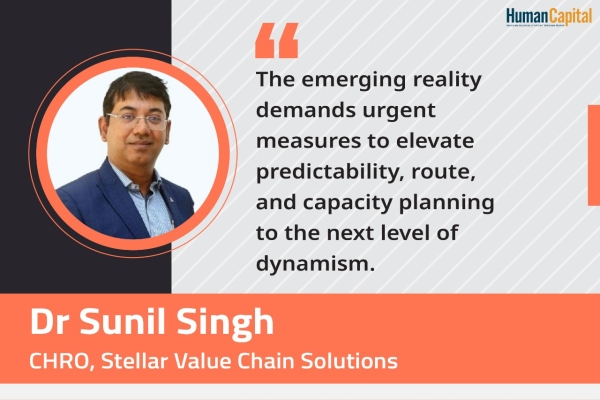With diminishing employee loyalties across companies and the need to hire more quality talent, leveraging technology in this space is the only way forward.
The past decade (2010-20) has witnessed the emergence of new-age, technology-backed organisations redefining traditional business models; from Flipkart and Snapdeal disrupting the retail landscape, OYO rooms disrupting the hotel businesses, Uber/Ola redefining mobility and WeWork redefining offices spaces. Looking back, these business models were unthinkable in the early 2000.
Throughout the decade, as new technologies gave birth to new business models democratising their products and services, traditional industries hopped on to imbibe those new technologies to help them become more effective and efficient. Adopting these technologies brought in a fresh perspective and an incremental change in their thinking. While most organisations had set up ambitious targets to achieve digitisation goals by 2020, these targets have indeed been met, but with a twist.
2020 was a year that surprised us all, both rationally and emotionally. Like an uninvited guest, the COVID-19 Pandemic challenged all factions of the traditional economy. Businesses that grew without any blip were the ones that had already boarded the technology train far ahead of the others. COVID-19, as the chief digital officer for most organisations, challenged employees to think new. It was during this time that the perils of not being digitally savvy were being felt.
During the pandemic, the primary aim among organisations was to keep their employees safe as well as to get the business back on its feet. In the modern retail business in particular, with supply side constraints and customers not wanting to step out due to safety concerns, it became challenging on multiple fronts. With numerous challenges and trying to figure out digital modes of collaboration, many employees burnt the midnight oil to come up with unique solutions to sustain operations. Ranging from reputed organisations in South Mumbai to government schools in rural India, everyone was left with no option but to restart their operations, but with a different mindset.
challenges and trying to figure out digital modes of collaboration, many employees burnt the midnight oil to come up with unique solutions to sustain operations. Ranging from reputed organisations in South Mumbai to government schools in rural India, everyone was left with no option but to restart their operations, but with a different mindset.
There are 4 major areas where we see technologies emerging to redefine HR services:–
• Employee Wellness
• Talent Attraction
• Talent Engagement
• Organisation Structure
Employee Wellness
Today, it has been experienced that Employee Experience through Employee Wellness has literally transformed in practice and has gained paramount importance since the pandemic, and in my opinion, will continue to be an important pillar of HR. The pandemic has made us realise the importance of physical and mental wellness with remote teams and household duties such as parenting being done parallelly along with work. A range of service providers are now available to provide employees with continuous orientation on physical wellness including pre-loaded daily exercise schedules through their customised apps encouraging employees to practice a healthy lifestyle.
Today, HR functions are leveraging wellness app providers such as TATA 1mg, MediBuddy, Ekincare, etc. to nudge employees over a healthy lifestyle, and are thereby, creating awareness. These apps can also be used to gamify healthy behaviours amongst employees leading to an overall healthy workplace. Similarly, apps have also emerged on the mental wellness front, making the offerings more accessible. Providers such as 1to1Help and InnerHour etc. offer customised programmes. Wellness helps to improve our overall employee experience. Confidential counselling services too are a part of the package offered by these providers which are most needed at times of crisis. Counselling, which was also traditionally experienced in cushioned chairs in front of an expert, have transformed to provide the same service virtually, improving the convenience of availing mental health services for employees or their families.
Talent Attraction
Talent Attraction is another big concern staring at HR nowadays. With attrition levels rising across all industries due to various reasons, attracting and selecting the right talent is critical now more than ever. Most employers are leveraging formal social media tools to brand their workplace and attract talent. LinkedIn, the prominent platform, can be harnessed to create advocacy about one’s organisation. Added to this, the talent landscape is also preparing for a shift in the coming decade.
With an increasing number of millennials waiting to enter the workforce, organisations need to anticipate the technological needs of this group to attract and retain them. A traditional talent acquisition policy may not cut the ice with the mobile-only generation which grew up on social media. Robust interviewing and assessment tools have become mainstream, and facilitate talent selection with high specificity. Virtual interviewing tools, robotic interviews and AIbased personality profiling which is generated basis candidate responses and game-based psychometric assessments are gaining popularity amongst new-age organisations. With diminishing employee loyalties across companies and the need to hire more quality talent, leveraging technology in this space is the only way forward.
Seeing blank names with only voices on a Microsoft Teams meeting has become common for almost a year. While this gave comfort to most employees to attend meetings in their casual home clothes, it also made it difficult for managers and HR teams to gauge the engagement levels of employees. If companies want to maintain a healthy level of engagement in the digital age, technology disruption is no longer a mysterious figure to be frightened of. It has evolved into a valuable friend in ensuring that employees are productive, happy, and healthy.
If companies want to maintain a healthy level of engagement in the digital age, technology disruption is no longer a mysterious figure to be frightened of.
Of course, digital innovation does not automatically lead to increased engagement. It boosts the company’s engagement culture by offering the required communication and collaboration tools. They can only better comprehend the company’s strategy, performance measures, and peoplebased procedures if they have platforms to engage with one another. Technology may assist with anything from pre-onboarding through performance reviews to tenure recognition. The following are some examples of tech-driven engagement strategies:
• Using intranets and closed-circuit portals to centralise information, employees can pick and choose what information they wish to learn about the company
• To better comprehend company procedures, virtual instructions can be accessed via chosen devices
• Gamification to make knowledge acquisition easier and to keep colleagues informed about their own development
• Internal platforms to increase employee relationships and improve network linkages
• A platform for hosting workshops and sharing best practices
• Bite-sized learning videos/learning modules that can be assessed through mobile devices / web to deliver the content when required and when the learner is ready to learn
Many organisations have had success using AI-enabled Chatbot that interacts with staff at certain internal locations. Employees can voice their dissatisfaction, uncertainties, and unedited input through the channel. If employees provide unfavorable feedback, the Chatbot continues the conversation to learn more about the fundamental reason. Post this, the HR team conducts an analysis and collaborates closely with line managers to address the issue.
I believe it is critical for HR professionals to quickly grasp the behavioural power of modern technology, to comprehend how technology triggers, directs, and reinforces human behavior and to maximise the synergies between employee personality traits and organisational goals.
The last but the most important aspect technology is changing is the organisation structure. With the adoption of rapid communication technologies such as WhatsApp, Telegram and Microsoft Teams; communication has become swift and effective, reducing time and adding greater value. Communicating something as important as a vision or strategy can happen in a span of minutes, thanks to these technologies. On the other hand, there are technologies that have also digitised various aspects of work such as data reporting, dash-boarding, data analysis, etc.
With key aspects of jobs such as communication, engagement and reporting being digitised, this puts pressure on the hierarchical organisation structures as such structures go contrary to the speed of technology. More such technologies in the future will force large organisations to return to flat hierarchies to keep up with the pace of the market, demanding organisation structures to be simple and lean. Flatter organisations will have the advantage of being agile to transform swiftly in the face of uncertainty.
Besides the mentioned four areas, there are many other areas of HR that are increasingly seeing technological disruption. With rampant changes in the business context and the need to be more digitally savvy, HR often finds themselves lagging on this agenda taking a reactive approach. The coming decade (2021-30) will be a true test for the HR function as the new generation entering the workplaces is a digital-first generation and will discard any organisation norm rooted in traditional thinking (see fig). With digital access growing rapidly across the country, we will soon find organisations moving to digital-first processes. HR should ensure that we not just onboard ourselves on this journey but navigate our organisations in the right course.
.png)
Change Management is never easy and so is the case with digital change management. For starters, HR function needs to re-group at their drawing boards to answer four major questions facing them today.
• How can HR improve access to all HR services across the organization?
• How does my new talent landscape look like and what are their preferences?
• What kind of employee insights helps my organisation gain a competitive advantage in the industry we operate in?
• How can I make my organisation agile to the VUCA times we live in?
While the above list of questions is not exhaustive, it surely is a start. With a well laid out long-term plan on digital accompanied by careful implementation, moving to a digital-savvy culture is possible. As mentioned in my first paragraph, moving to a digital approach fundamentally requires a shift in mindset and the rest follows!

Do you think hybrid work arrangements would be a common feature of the workplaces going forward?
Trending
-
SBI General Insurance Launches Digital Health Campaign
-
CredR Rolls Out 'Life Happens' Leave For Its Employees
-
Meesho Announces 30-Week Gender-Neutral Parental Leave Policy
-
Microsoft Unveils Tech Resilience Curriculum To Foster An Inclusive Future
-
60% Indian Professionals Looking For Job Change Due To COVID: Survey
-
SpringPeople And Siemens Collaborate For Digital Transformation Push
-
86% Professionals Believe Hybrid Work Is Essential For Work Life Balance: Report
-
Almost 1 In Every 3 People's Personal Life Affected Due To Work Stress
-
Meesho Rolls Out Reset And Recharge Policy For Employees
-
80% Of Talent Leaders & Academics Say Pandemic Changed Skill Needs For Youth: Report
-
Hero Electric Rolls Out 'Hero Care' Program For Employees
-
Human Capital In Collaboration With ASSOCHAM Hosts Virtual Conference
-
IKEA India, Tata STRIVE Collaborate To Create Employability And Entrepreneurship Opportunities
-
SAP India, Microsoft Launch Tech Skilling Program for Young Women
-
DXC Technology, NASSCOM Collaborate For Employability Skills Program
-
Lenskart To Hire Over 2000 Employees Across India By 2022
-
Mindtree Launches Learn-and-Earn Program
-
Tata AIA Extends 'Raksha Ka Teeka' To Its Employees
-
Swadesh Behera Is The New CPO Of Titan
-
NetConnect Global Plans To Recruit 5000 Tech Professionals In India
-
Hubhopper Plans To Hire 60% Of Indian Podcasters By 2022
-
Corporate India Needs More Women In Leadership Roles: Report
-
Aon to Invest $30 Million and Create 10,000 Apprenticeships by 2030
-
Tech Mahindra Launches ‘Gift a Career’ Initiative for Upskilling of Youth
-
40% Women Prefer Flexible Working Options in Post-COVID World: Survey
-
3 out of 4 companies believe they can effectively hire employees virtually: Report
-
Vodafone , CGI and NASSCOM Foundation launch digital skills platform
-
Odisha: Bank, postal employees to deliver cash for elderly, differently-abled persons
-
Skill India launches AI-based digital platform for "Skilled Workforce"
-
Hiring activity declines 6.73% in first quarter: Survey
-
70% startups impacted by COVID-19 pandemic
-
Bajaj Allianz Life ropes in Santanu Banerjee as CHRO
-
Over 70 Percent MSMEs look at cutting jobs to sustain businesses
-
93 Per Cent employees stressed about returning to office post-lockdown
-
Johnson & Johnson India announces family benefits for same gender partners
-
Indian firms turning friendly towards working mothers
-
Welspun India names Rajendra Mehta as new CHRO
-
Wipro partners with NASSCOM to launch Future Skills platform



Human Capital is niche media organisation for HR and Corporate. Our aim is to create an outstanding user experience for all our clients, readers, employers and employees through inspiring, industry-leading content pieces in the form of case studies, analysis, expert reports, authored articles and blogs. We cover topics such as talent acquisition, learning and development, diversity and inclusion, leadership, compensation, recruitment and many more.
Subscribe Now












































Comment